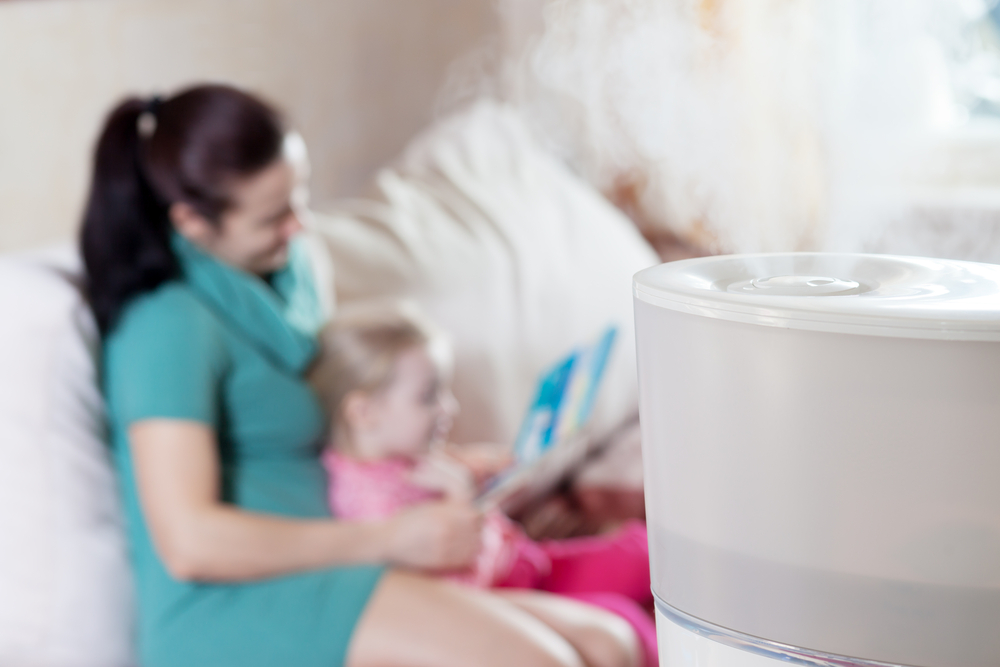Using a Humidifier Can Hydrate and Soften Your Skin!
Humidity is the amount of water droplets suspended in the air and is an important variable for your health. It is generally recommended to keep your relative indoor humidity between 40 percent and 60 percent. Relative humidity describes how much water vapor is in the air, compared to how much there potentially could be.1 When the temperature of the air is warmer, greater amounts of water vapor may be present than when the air is cold.
While most people find a relative humidity in this range most comfortable, mite populations are minimized when the relative humidity is below 50 percent, and most species of fungi cannot grow unless the relative humidity exceeds 60 percent.2
Additionally, keeping indoor humidity above 60 percent in the winter months may result in condensation on the windows and ice formation inside your home. On the other hand, when your indoor humidity is too low, it can impact your skin, eyes and respiratory system; In other words, both high humidity and low humidity may have detrimental effects on your health and wellness.
Using a Humidifier May Reduce Effects of Low Humidity on Your Health
Maintaining humidity in your home within a desirable range may help to reduce respiratory symptoms during the summer when the weather is hot, and in winter months when the air is often dry. When the relative humidity in your home is below 40 percent, you may experience dry skin, itchy eyes, and irritated throat and nasal passages.3 It can also raise your risk of contracting a cold.
If your home’s humidity is higher than 60 percent, it increases the risk of mold and fungal growth and may make your home feel stuffy. You might notice condensation on the walls, floors and windows, increasing the risk of triggering growth of bacteria and dust mites. These allergens may increase your respiratory problems and provoke flare-ups of allergies and asthma.4
Dry air in your home may cause moisture in your skin and respiratory tract to evaporate more quickly. Adding moisture may help with symptoms such as dry skin, irritated eyes, frequent coughs, bloody noses and sinus headaches. Maintaining humidity in your home within a range of 40 percent to 60 percent relative humidity can help:5
|
Prevent influenza In one meta-analysis6 of nine epidemiological studies, researchers found the incidence of absenteeism or respiratory infections was lower in people who worked or lived in environments with a midrange relative humidity. Another study7 demonstrated prolonged exposure to high or low relative humidity was associated with an increased risk of respiratory symptoms in teachers. Authors of a third study8 found humidifiers may reduce the risk of catching the flu. With low relative humidity, the influenza virus retained maximal infectivity, but experienced rapid inactivation at indoor relative humidity greater than 40 percent. |
|
Create more productive cough Dry air increases the risk of producing a dry unproductive cough. Adding humidity moisturizes your airways, which makes your cough productive and therefore releases trapped or sticky phlegm. |
|
Moisten membranes Dry air may irritate sinuses, your throat and your eyes. Over time this may trigger inflammation in the mucous membranes lining your respiratory tract, a natural barrier to viruses causing colds and other infections. In low humidity, certain viruses are also able to survive longer, further increasing your risk for contracting an infection. In one study,9 nasal congestion was related to both temperature and humidity of inhaled air, perhaps more than any other variable. The interaction between temperature and humidity influences nasal cooling, as air moves through your nasal cavity. This may be detected by sensors inside the nose, which stimulate the perception of airflow being moved easily or obstructed. While high humidity can trigger nasal congestion, very low is known to increase the feelings of congestion as drying sinus membranes irritate them further. |
|
Reduce dry eye If you suffer with dry irritated eyes or low tear production, low humidity may increase the evaporation of tears and disrupt the moisture balance necessary for healthy comfortable eye surface.10 |
|
Prevent dry skin Combined with colder temperatures, reduced humidity may deplete your skin of moisture, triggering what is often referred to as “winter itch.” This may also cause small cracks in the skin surface, increasing your risk of getting sick by providing an entryway for potentially dangerous pathogens. This is especially true in winter months and dry climates where humidity levels frequently drop below 10 percent.11 |
|
Reduce snoring An increased amount of moisture in the air may help reduce snoring as dry airways are not sufficiently lubricated, making snoring worse. Sometimes adding humidity to the air by running a humidifier at night may be enough to relieve the symptoms. This is especially true if your snoring is due to nasal congestion triggered by allergies.12 |
|
Improve your hair Low levels of humidity not only draw water and moisture from your skin and eyes, but also from your hair and scalp.13 During dry seasons it is important to maintain relative humidity and use proper hydration to help keep your scalp moisturized. You may also protect your scalp and hair from dry air with Moringa oil. |
|
Reduce allergy and asthma symptoms You may be able to reduce symptoms of allergies and asthma by using a humidifier correctly. Dry sinuses and airways increase your risk to allergic reactions.14 However, it is also important to maintain your humidifier in order to reduce your risk the device produces bacteria and mold, increasing your symptoms. |
What Type of Humidifier Do You Own?
When using a humidifier or dehumidifier, it is helpful to know how much humidity you have in the air.15 The best way to test levels in your home is with a hygrometer. This device looks like a thermometer and measures the amount of moisture in the air. Some humidifiers come with a built-in hygrometer, or humidistat, to help the humidifier maintain relative humidity in your home at a healthy level. There are several types of humidifier devices that basically emit vapor or steam into the air to increase your relative humidity:16
- Central humidifiers. These are built into your heating and air conditioning system and designed to humidify the whole house, keeping it at a steady level year-round.
- Impeller humidifiers. These machines produce a cool mist using a rotating disk that passes through a tank of water.
- Evaporators. This uses a fan to blow air over a wet filter or belt, dispersing humidity in the air.
- Steam vaporizers. This apparatus creates steam and then cools before leaving the machine. For safety, avoid these if you have children in the home as the hot water may cause burns if spilled.
- Ultrasonic humidifiers. This type produces a cool mist using an ultrasonic vibration.
Do You Need a Dehumidifier?
At times, the humidity in the air may get too high, which is common during summer months. In this case, it’s a good idea to take steps to reduce the indoor moisture.17 Your air conditioning unit performs the function of a dehumidifier while cooling the air. A second option is a dehumidifier. This electrical device collects excess moisture from the air, thus lowering the humidity levels.
You may need a dehumidifier if you live in a small space with limited ventilation, such as a small apartment or basement apartment.18 Even in dry climates, these spaces may build up excess humidity. Frequent condensation on your windows in certain areas of the home may indicate the need for a dehumidifier. Dehumidifiers may also help reduce levels of dust in your home and reduce your energy costs as your air conditioning unit works harder when the air in your home is more humid.
Maintain Your Home Humidifier
Appropriate maintenance of your humidifier is important as dirty reservoirs and filters can quickly breed bacteria and mold.19 Even if you do not suffer from respiratory conditions such as asthma and allergies, additional bacteria and mold in the air have the potential to trigger flu-like symptoms and even lung infections.20 To keep your humidifier clean and functioning well, be sure to follow the guidelines recommended by the device manufacturer.
Most humidifiers have a filter that requires cleaning or changing. The tanks must also be cleaned in the exact manner described by the manufacturer. Never let water sit in the machine when it’s not running as film can form at the top, encouraging the proliferation of bacteria in an enclosed tank.21 When not in use, empty the water and clean the tank, even if you’re skipping use for just one day.
You may experience symptoms when regularly inhaling impurities if your humidifier has not been consistently cleaned.22 These impurities may aggravate symptoms of allergies and asthma or cause what is known as “humidifier fever,” a lung condition that develops when you inhale contaminated vapors. Symptoms can include cough, fever, chills, body aches and lung inflammation.
Even when your machine is in use on a daily basis, it’s important to empty it, wipe down the reservoir and refill it with clean water every few days.23 Consult your manufacturer’s recommendations about the type of water used in your device. Most recommend distilled or demineralized water, which makes your humidifier less likely to expel white mineral dust into the air, and consequently less likely for the dust to be inhaled.
Unless otherwise recommended by the manufacturer of your device, you can keep your machine running clean using white vinegar, hydrogen peroxide, a soft bristle brush, water and clean towels.24 Before doing any cleaning, remember to unplug the unit from the wall and only disassemble what the manufacturer recommends.
Use enough white vinegar to fill the areas where the water regularly comes in contact with the tank and let everything soak for 30 minutes to break down buildup of any mineral deposits.25 Follow this with a soft bristle brush to remove any stuck-on residue.
Consider disinfecting the water tank for 30 minutes by filling it halfway with a mixture of 1 teaspoon of 3 percent hydrogen peroxide and 1 gallon of water. Swirl this around the tank and wait 30 minutes before removing the mixture and flushing it thoroughly with water. Wait for everything to dry completely and reassemble.
Ultrasonic Humidifiers May Offer Additional Benefits
The main types of humidifiers function as evaporative or ultrasonic. An evaporative humidifier uses an internal fan to pull air into the unit and pass it across a water-saturated wick filter to absorb moisture before it is released back into the room.26 On the other hand, an ultrasonic humidifier uses high frequency sound vibrations to produce a fine mist of water that is expelled to add moisture into the air.27 An ultrasonic humidifier is often considered to be quieter, generally has no filter factored into the design and saves on operating costs.
However, there are trade-offs. If an ultrasonic humidifier is used with tap water, you’ll get dust in the room as there is no filter to absorb the mineral scale deposits. Because there is no heater involved, the unit may be safer to use around children and, without heat, reduce the risk of discharging bacteria.
Although an evaporative humidifier is less expensive, you must replace wick type filters. So the lower upfront cost is followed by higher maintenance costs. On the other hand, ultrasonic humidifiers generally cost more initially, do not use filters and require cleaning at home without the additional cost of replacing parts.28
Some add essential oils into their humidifier as they can improve mood and health. Although you may already have a humidifier working in your home, an essential oil diffuser may be your better option for aromatherapy.29 To preserve the maximum essence of the original plant, it’s critical to use a cool mist humidifier, which is why some choose to use essential oil in their cool mist ultrasonic humidifiers. Any method using heat tends to destroy some of the properties of the essential oils.30
Although essential oils can be placed in a humidifier, ultimately these devices are not designed for this purpose. In some cases, the oils may break down the plastic parts in your device and, since most humidifiers run continuously, you’re not able to control when the oils are released in the air. One designer of humidifiers for the home31,32 recommends not using essential oils in their ultrasonic humidifiers.
Hydrate and Soften Your Skin
Your skin and mucous membranes may take the brunt of dry air, which can leave your skin feeling tight, rough and itchy, and your mucous membranes irritated and inflamed. It is important to tend to your dry skin internally and externally. Using a humidifier helps to replace moisture in the air, but internal variables may be just as important.
Chief among those internal variables are omega-3 fats, which will help normalize your skin fats and prevent dehydration in your cells.33 Fatty acid deficiency may manifest in a variety of ways, but skin problems such as eczema, thick patches of skin and cracked heels are common. Omega-3 fats have an anti-inflammatory effect that may help soothe irritated skin and help give you a smoother complexion.
Dietary omega-3 fats are found in fish. As a general guideline, the smaller and closer to the bottom of the food chain the fish is, the less contamination it will have accumulated. These fish include sardines, anchovies, mackerel and herring. Wild-caught Alaskan salmon is another healthy option.
To treat dry skin immediately, topical pure coconut oil is a simple and all natural remedy.34 As it is absorbed, it helps reduce the appearance of fine lines and wrinkles by keeping your connective tissues strong and supple. Nearly 50 percent of the fat is lauric acid that your body converts into monolaurin, which has antiviral, antibacterial and anti-protozoan properties.35 When used topically, it can be used by itself or with your favorite essential oil. Make sure you’re using a high-quality essential oil safe for topical application.
It is also critical to stay well-hydrated since your skin becomes rough and dry when the outermost layers of the epidermis lacks water. Organic and locally grown deeply colored fresh vegetables are another wonderful addition to help maintain the health of your skin.
Although fresh vegetables are important, adding fermented vegetables to your dietary regimen will improve the health and quality of both your skin and your gut. Promoting the growth of beneficial intestinal bacteria may interact with organisms on your skin and help with collagen production.36 Avoiding sugars, fructose, grains and processed foods is likely the most important step you can take to improve your overall skin health, regardless of the season of the year.
- 1 National Asthma Council Australia, February 16, 2016
- 2, 6, 11 Environmental Health Perspectives, 1986; 65:351
- 3, 4, 15, 16, 20, 21 MayoClinic, Humidifiers: Air Moisture Eases Skin, Breathing Problems
- 5 Medical News Today, June 23, 2018
- 7, 14 International Archives of Occupational and Environmental Health 2016; 89(5):729
- 8 PLOS|ONE February 27, 2013 doi.org/10.1371/journal.pone.0057485
- 9 PLoS ONE, 2011; 6(10): e24618
- 10 PRWeb November 20, 2013
- 12 Huffington Post, April 27, 2014
- 13 Huetiful, How Does Low Humidity and Cooler Temperatures Affect Your Hair and Scalp
- 17, 18 Allergy and Air, April 10, 2015
- 19, 22 Sylvane, Tips for Maintaining Your Humidifier
- 23 Compact Appliance, October 9, 2014
- 24, 25 Allergy and Air, January 22, 2016
- 26 Sylvane, Frequently Asked Questions About Humidifiers
- 27, 28 The Spruce, April 11, 2018
- 29, 30, 32 The Soothing Air, Can I Use Essential Oils in Humidifier
- 31 Crane, March 19, 2015
- 33 Agro Food Ind Hi Tech, 2012;23(4):10
- 34 Amazing Facts, 5 Amazing Benefits Of Coconut Oil For Skin
- 35 Journal of the American Oil Chemists’ Society, 2015;92(1):1
- 36 Huffington Post, August 3, 2017





Leave A Comment